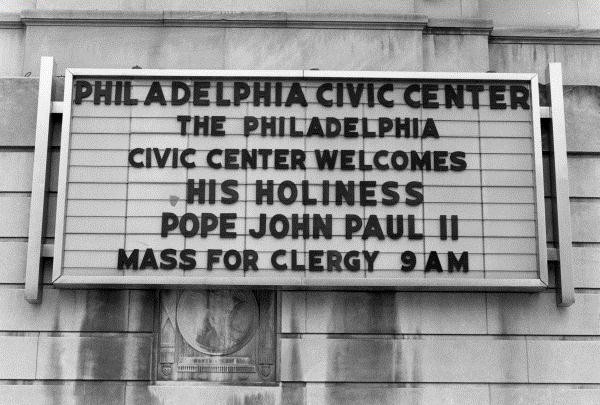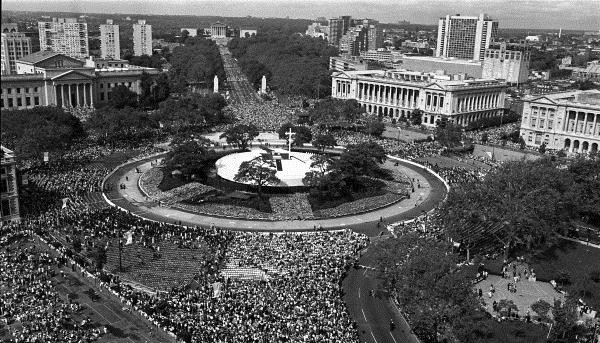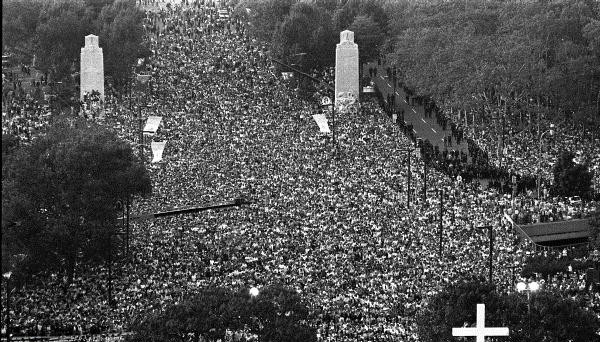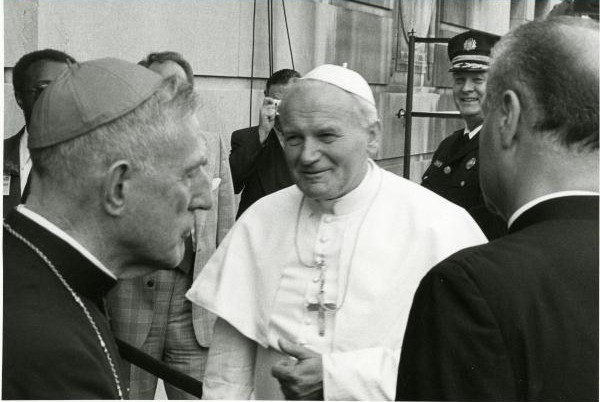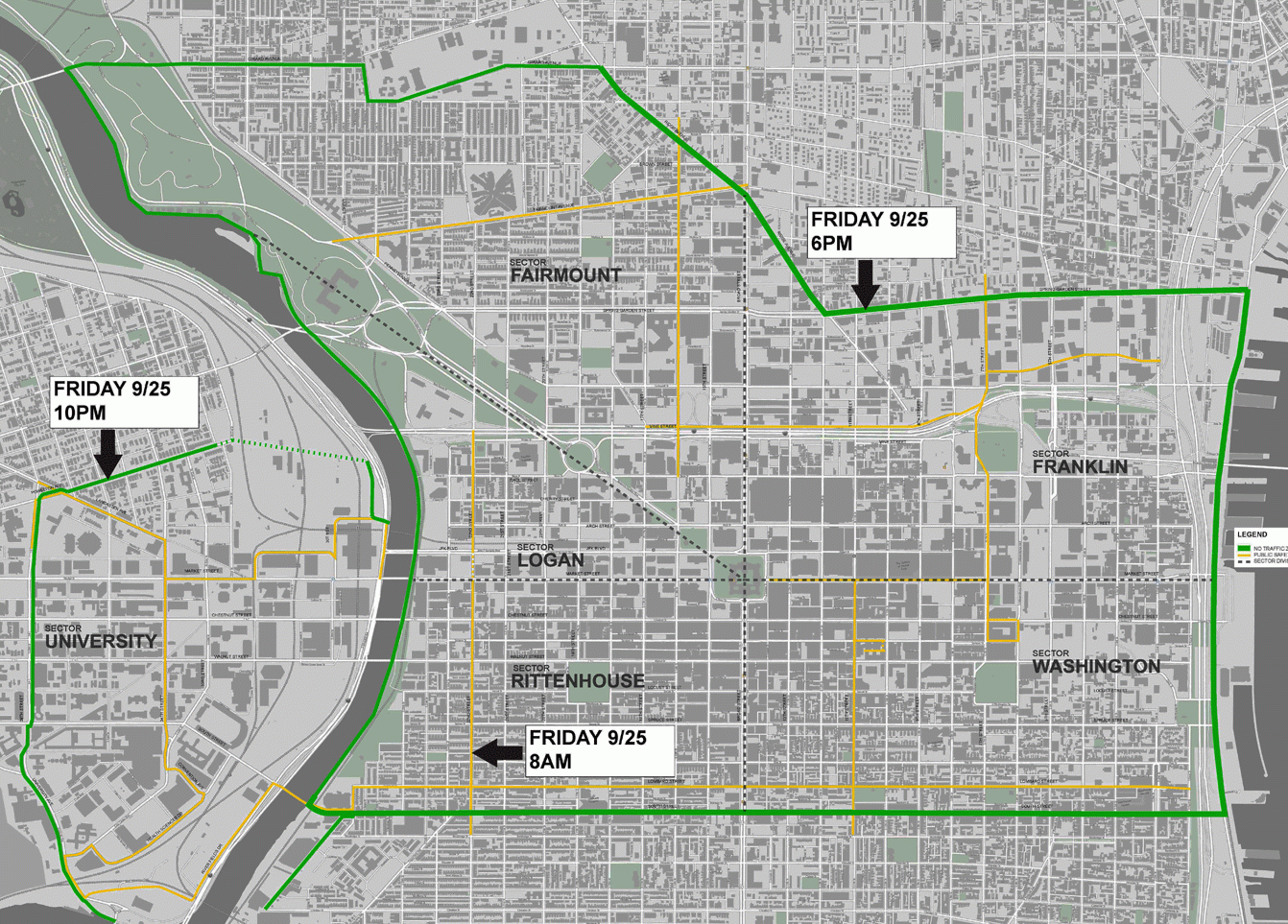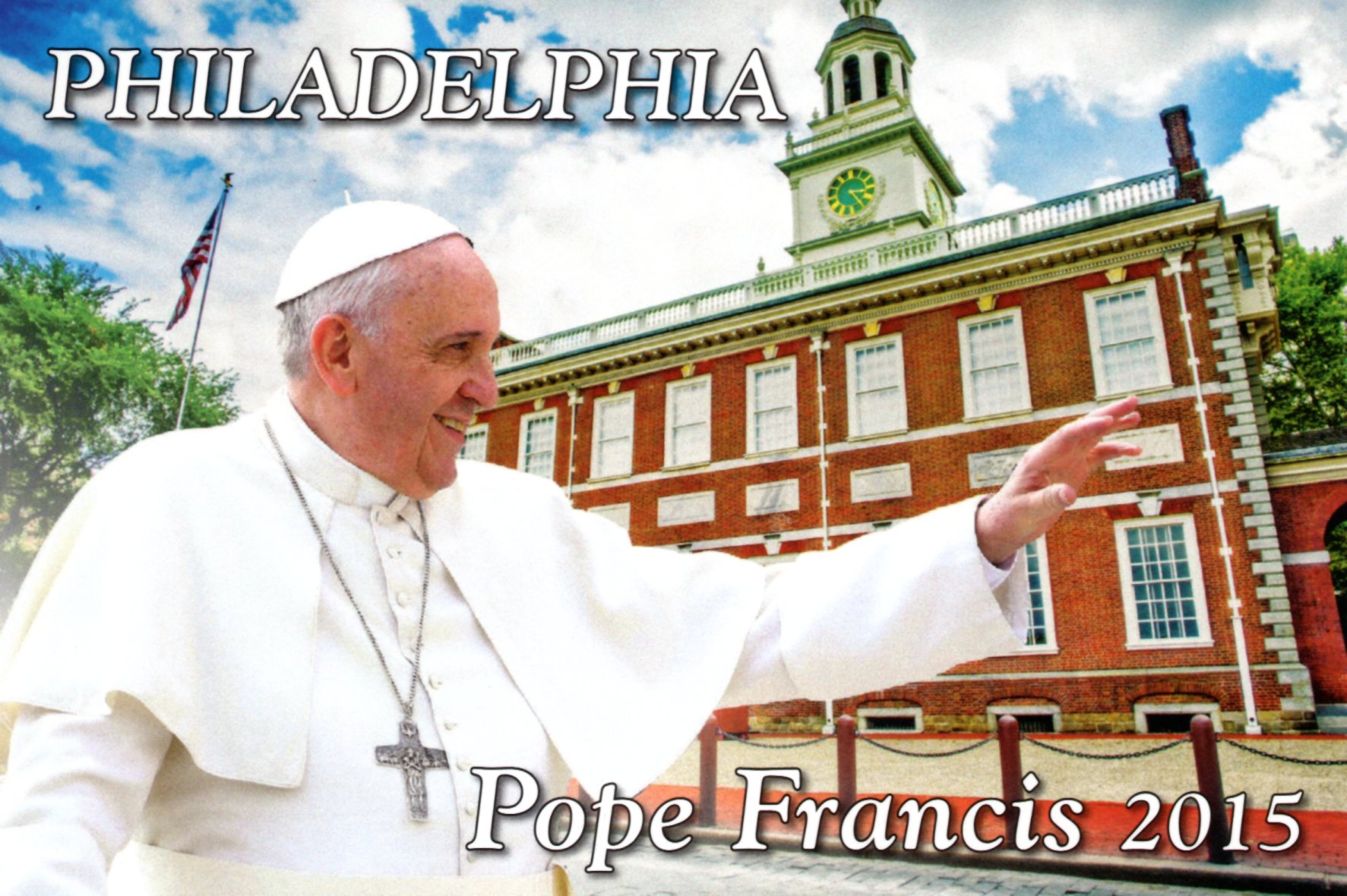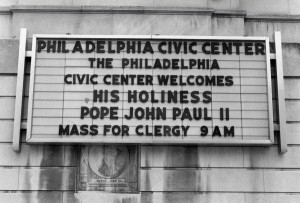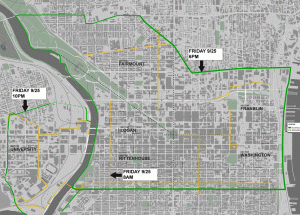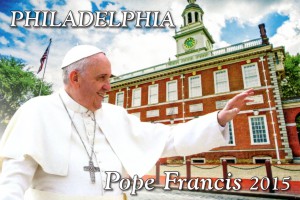Papal Visits
Essay
Popes use their visits to encourage faith, emphasize their priorities, and fulfill their role as pastors. The places visited use these trips to highlight their successes, history, and culture on an international stage. Prior to the visit of Pope Francis (b. 1936) to Philadelphia on September 26 and 27, 2015, only one other pope had made an official visit to the city. Pope John Paul II (1920-2005) came on October 3 and 4, 1979, as part of his first trip to the United States as pope. As Cardinal Wojtyła, he had visited Philadelphia in August 1976, representing Pope Paul VI at the International Eucharistic Congress during the celebration of the nation’s bicentennial.
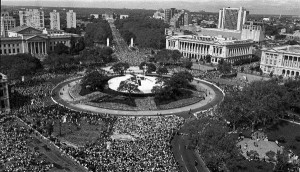
John Paul II enjoyed a close relationship with John Cardinal Krol (1910-96), archbishop of Philadelphia (1961-88), a fellow Pole with whom he shared similar views concerning theology and church discipline. The large Catholic population of the archdiocese (more than 1.3 million), the historical significance of the city, and the pope’s friendship with Cardinal Krol were all factors in Philadelphia’s selection for a visit.
Before Philadelphia, John Paul II visited the General Assembly of the United Nations in New York, where he enunciated themes repeated in Philadelphia: the dignity of the human person, fundamental human rights, and the primacy of spiritual and moral values over material and technological progress. In 1979, Philadelphia was like many other urban centers, experiencing declining influence relative to the suburbs. During the 1972-80 tenure of Mayor Frank Rizzo (1920-91), a time of white flight to the suburbs and increases in crime rates, taxes, and poverty, tensions ran high between white residents and African Americans. In this context, in the Cathedral of Saints Peter and Paul, the pope prayed that everyone in the region would “succeed in making your inner city and suburbs places where people are no strangers to each other, where every man, woman and child feels respected; where nobody feels abandoned, rejected or alone.” In his homily at the Mass in Logan Circle that followed, John Paul urged the estimated 400,000 participants to preserve the human and Christian values—especially liberty and justice—of the city’s and the nation’s heritage. Before leaving, the pope met with seminarians and priests, Hispanic Catholics, and Ukrainian Catholics.
World Meeting of Families
Philadelphia’s second opportunity for a papal visit emerged in connection with the city’s hosting of the 2015 World Meeting of Families, a triennial event established by John Paul II to encourage discussion of the challenges and contributions of family life. The two-day papal visit was planned to encompass the meeting’s concluding events, a family festival (September 26) and a Mass on the Benjamin Franklin Parkway (September 27). Organizers projected that the Mass featuring the pope would draw between one and two million people.
In addition to appealing to the local Catholic community, the prospect of a second papal visit also drew support from civic and business leaders eager to encourage business opportunities and tourism by presenting Philadelphia as a city of global stature. A delegation including Robert J. Ciaruffoli (b. 1951), a top executive at accounting firm Baker Tilly, and Daniel Hilferty (b. 1957), Independence Blue Cross CEO, joined Mayor Michael Nutter (b. 1957), Governor Tom Corbett (b. 1949), and Archbishop Charles Chaput (b. 1944) in flying to Rome in March 2014 to encourage the pope to come to Philadelphia. The religiously diverse Executive Leadership Cabinet of the World Meeting of Families also reflected broad support.
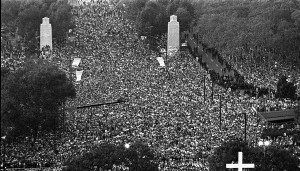
The pope’s vigorous engagement with contemporary issues added to public interest in the visit, as evinced by newspaper articles, op-eds, and letters on the subject. Since his election in March 2013, the pope called for serving the urgent needs of migrants and refugees, protecting the environment, and making economic systems more just. He also sought to persuade the Church to be more concerned with compassionate service to all, especially the marginalized, rather than with a rigid adherence to doctrinal orthodoxy. His message resonated not only with Catholics, but also with many others. At the same time, the pope’s insistence that humans had a moral obligation to become good stewards of the earth, instead of degrading the environment and inflicting suffering on the poor across the globe, led some conservatives to argue that the pope should steer clear of forays into “scientific” matters.
The Pope’s Itinerary
Like John Paul II before him, Francis’ arrival in Philadelphia followed an address at the United Nations in New York. Echoing themes from that address, in Philadelphia Francis—using the same lectern that Abraham Lincoln used to deliver the Gettysburg Address—spoke about religious freedom and immigration at Independence Hall on September 26. He also met with selected prisoners and their families at the Curran-Fromhold Correctional Facility before celebrating a concluding Mass on the Benjamin Franklin Parkway on September 27.
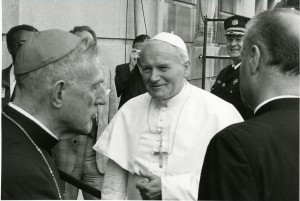
While the two papal visits have many similarities, fund-raising for the 2015 visit of Pope Francis differed from its 1979 precedent. In 1979, after Mayor Frank Rizzo announced that the city would cover the $205,569 expense of the platform and decorations for the public Mass, the ACLU filed and won a lawsuit against Philadelphia for violating the First Amendment. In 2015, no public funds were to be used to cover the estimated $45 million cost of infrastructure, security, and cleanup for the World Meeting of Families and the papal visit. A development committee chaired by Eustace Mita, CEO of Achristavest, a waterfront development company, led the fund-raising. In addition to appealing to local businesses, foundations, and individual philanthropists for most of the needed funds, the committee created opportunities for supporters to purchase merchandise online, to donate $10 to light a candle for one’s intentions at the Cathedral Basilica, and to designate the World Meeting of Families as a preferred charity to receive a percentage of purchases made on Amazon.com.
Security measures in 2015 were also far more robust than in 1979, which preceded the era of the 9/11 attacks and the rise of al Qaeda and ISIS. The first papal visit had no secure vehicle perimeter to block traffic, nor was there screening of visitors with magnetometers or high fences severely restricting access to the principal papal venues. The 2015 visit, designated a National Special Security Event by the U.S. secretary of Homeland Security, led the city to implement unprecedented travel restrictions, criticized by some as excessive. These measures included closing the Benjamin Franklin Bridge, the Vine Street Expressway, and large stretches of the Schuylkill Expressway to private vehicles and preventing incoming traffic into the three-square-mile papal security perimeter for the entire weekend.
About one month before the pope’s visit, city officials and World Meeting of Families supporters mounted a campaign to undo negative publicity brought by uncertainties over security and transportation issues, including distribution of “OpeninPHL” kits to downtown businesses and assurances that the city would take the event in stride.
Despite the inconvenience caused by the travel restrictions and disruption created by the huge influx of visitors, Philadelphia expected to net more than $400 million in economic benefit from the 2015 papal visit. Hotels and restaurants expected to reap the greatest profit, but local merchants—especially the official retail vendor, Aramark— also stood to benefit from the selling of papal paraphernalia, including the papal bobblehead doll with cheesesteak in hand, T-shirts, coffee mugs, and religious articles. In the final months prior to the pope’s arrival, local media intensified their coverage of the preparations for the papal visit, providing daily updates as their papal clocks counted down to Francis’s visit, expected to be the largest event thus far in Philadelphia history.
William Madges, Ph.D., is a professor of theology in the Department of Theology and Religious Studies at Saint Joseph’s University. His most recent publication is a translation of Walter Kasper’s Pope Francis’ Revolution of Tenderness and Love (New York: Paulist Press, 2015).
Copyright 2015, Rutgers University
Gallery
Backgrounders
Connecting Headlines with History
- Pope In Philly: FAQ (WHYY, July 13, 2015)
- PATCO readies rail passes for pope's visit (WHYY, July 16, 2015)
- Welcome Pope banner unveiled at cathedral (WHYY, July 29, 2015)
- Prison workshop crafting chair for Pope Francis (WHYY, August 24, 2015)
- Bike enthusiast plans a "pope ride" (WHYY, August 26, 2015)
- Papal tickets revive interest in visit for some suburban parishes (WHYY, September 7, 2015)
- SEPTA offering more subway stops for pope weekend and credits to monthly pass holders (WHYY, September 8, 2015)
- Philly side hustle will be on full display during papal visit (WHYY, September 17, 2015)
- Five things Philly officials learned from Pope Francis' visit (WHYY, November 11, 2015)
- Philadelphia to absorb $8 million in papal costs (WHYY, December 3, 2015)
- Security, vending plans for DNC convention differ from papal preparations (WHYY, March 28, 2016)
- New housing facility in the name of Pope Francis opens in Philadelphia (WHYY, May 4, 2016)
- Philly Orchestra sues for unpaid $70K bill from papal performances (WHYY, October 27, 2016)
- Extravaganzas and inconveniences: Philly becoming host with the most (WHYY, May 1, 2017)
Links
- Schedule: 2015 Apostolic Journey of Pope Francis to the United States of America
- For Teachers: The Vatican and Social Change: The Pope Visits Philadelphia (Historical Society of Pennsylvania)
- World Meeting of Families 2015
- Papal Visit Playbook (World Meeting of Families)
- A Hope For The Pope Under The Gold Dome (Hidden City Philadelphia)
- The Pope 2015 Visit to Philadelphia (Collection from Philadelphia Inquirer, Daily News, Philly.com)
- The Holy See
- Archdiocese of Philadelphia
- Catholic News Service
- Ticketed Areas for Pope's Visit (Philly.com, September 3, 2015)
- Papal parade plans released after public outcry over required tickets (Philly.com, September 4, 2015)
- Address of the Holy Father at Independence Hall (The Holy See)
